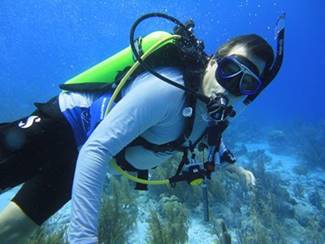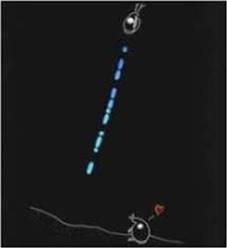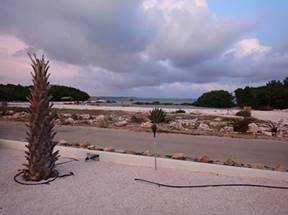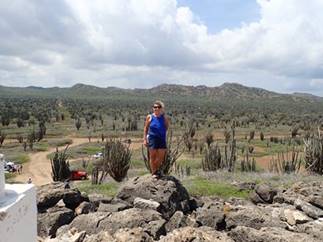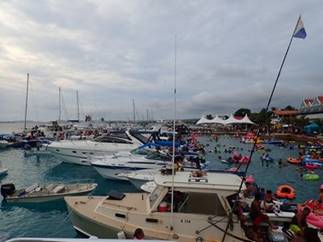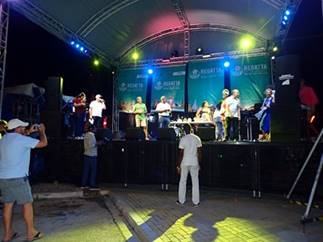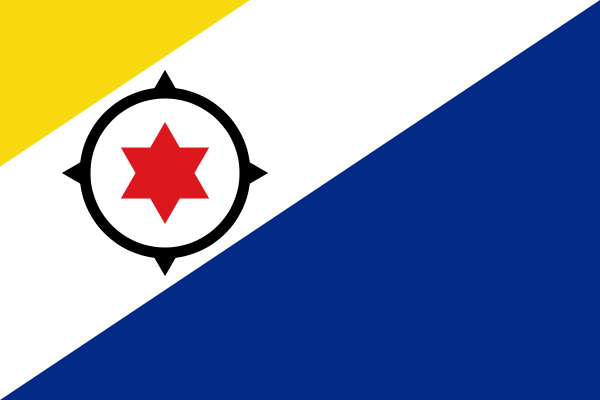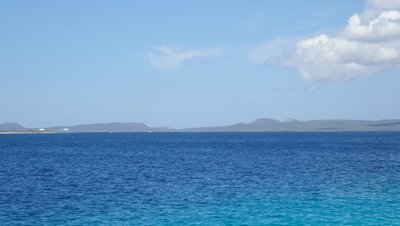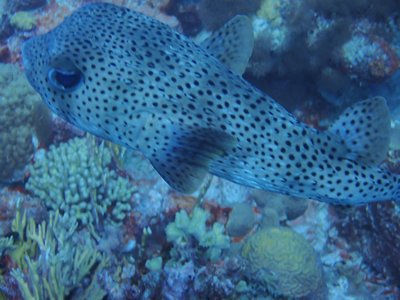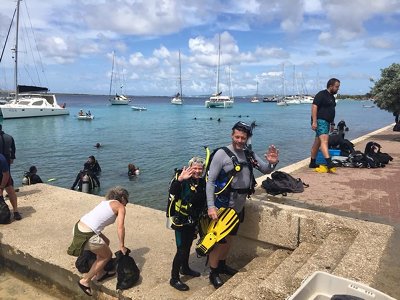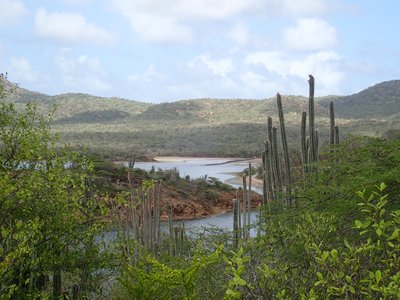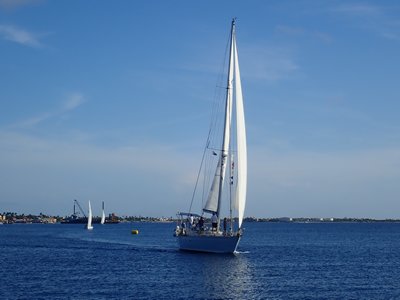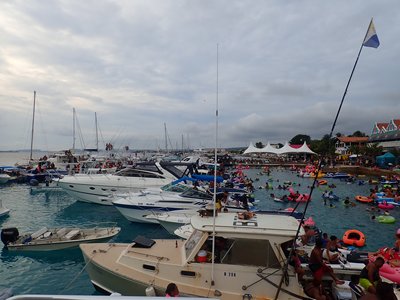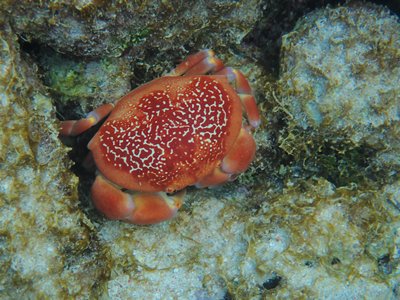Bonaire (The 'B' of the ABC Islands), SW Caribbean

Bonaire (The ‘B’ of the ABC Islands, Caribbean Netherlands) 12O09.13’N, 68O16.71’W 6 September to 28 October 2018
Monday 3 September 2018, Trinidad to Bonaire – Port Kralendijk, 464 miles, 74 hrs 20 minutes, (3 days, 2 hrs, 20 mins), 6.2 knots average speed, 17.1 engine hours, 36 night hours. Total Miles since Falmouth, August 2016: 11781 On raising our anchor we hooked a ‘hook’ – a small anchor with its line wrapped all around our chain, fortunately not attached to anything. We were able to cut it free with no harm done; just a slight delay in our departure from Trinidad, which wasn’t a problem as we had 460 miles to cover that would take just over 3 days. It was necessary to head North initially, to approximately level with Grenada, then turn West to Bonaire, giving Venezuela a very wide berth. We figured a distance of 60 miles from the Venezuelan coast would suffice, keeping us out of pirates reach! Going into the first night our auto-pilot failed; a gearing issue irreparable without new parts. It was fairly windy with big-ish seas so we chose to hand steer overnight and set up ‘Harry the Hydrovane’ (self steering gear) at first light. Our shifts were cut to two hours on, two hours off. Our normal 4 - 5 hour shifts were a tad too long unable to leave the wheel for a pee or coffee! ‘Harry’ is wind operated, a great advantage over the battery powered auto-pilot, eliminating the need to run the generator or engine during a long sailing passage. The advantage of the auto-pilot is ease of use and adjustment to change in weather conditions.
Very cleverly, the small Hydrovane sail reacts to the wind direction and via a long steel rod operates a small rudder on the stern of the boat, keeping us sailing along in a nearly straight line. Correct sail trim is essential to balance the boat to avoid her weaving back and forth, like a drunk person staggering home! Harry also serves as our emergency steering, which, having once lost the use of our main rudder in the busy UK waters of the Solent, with a cargo ship approaching, a novice crew and 20 knots of wind, we decided a vital piece of equipment! The wind was coming from directly behind us filling our twin headsails beautifully, pushing the 25 tons of Lady Rebel along nicely. We achieved 190 miles in the first 24hrs - quick for us! A couple of small birds hitched a ride; a more favourable ride than the two meals we caught!
Thursday 6 September – Land Ahoy!
Anchoring is not permitted in Bonaire to avoid the destruction of the beautiful coral reefs. There are 42 mooring buoys for public use at $10/night, bargain, and if these are occupied mooring is provided in the marina, subject to availability, at considerably more cost. If all the buoys are occupied and the marina is full you are basically stuffed! Bonaire becomes not an option and a continued journey to Curacao is required – a further 40 miles! We were extremely lucky to arrive with just one mooring buoy available. Ian and Ann (s/y Tourterelle) kindly dinghied over and put a fender on the buoy to reserve it for us, once we were within one hour of arriving. They also assisted taking our mooring lines.
View of moorings and Lady Rebel from Karel’s Bar Checking in with Customs and Immigration was very easy; the offices being a very short walk along the sea-front. It was soon clear to see why Bonaire is a ‘must visit’, especially for cruisers and divers – oh, and ice-cream lovers, with two amazing parlours 😊 Soon into our stay we were meeting lots of new fellow cruisers, many of whom also participating in the Ocean Cruising Club ‘Suzie Too Rally’ beginning in November from Curacao, ending in Belize in April. I joined a 7.00am ‘noodling’ group – exercise in the water with a noodle and a walking group, that culminated in a coffee, smoothie or ice-cream, so with all this activity Bonaire became extremely sociable and that was without all the diving, evenings out, F1, rugby and the regatta! Bonaire is divers’ paradise. There are 18 dive shops on this small island! Ken and I have our own equipment and it was wonderful to dive the coral reefs directly from the boat. A permit is required from the National Park at $25US per person and a buoyancy test undertaken to ensure divers can remain at a steady level above the coral. Gloves are not permitted, again to stop divers touching the coral and destroying it. We did a total of 19 dives at various locations around the island plus a few at Klein Bonaire (a small island one mile to the West); some dives just the two of us, some with others, some from our dinghy, some from the shore, some from friends’ boats, some from Lady Rebel, some night dives, some wreck dives and a couple of Ostracod dives. The topography is amazing and sea-life plentiful with hundreds of varying species of fish, eels, rays, snakes, spiders, turtles, sea horses, octopus, crabs and squid to name but a few, all amongst stunning, colourful corals and plants in warm (280C) turquoise water.
Underwater Selfie!
The two Ostracod dives were incredible. A few days after full moon a phenomena, called bioluminescence, occurs; underwater fireworks by tiny creatures called Ostracods! We dove in complete darkness (without a dive light or camera flash) at sights away from the lights of the town. Having dived the sights earlier, in the daylight, we were able to get our bearings for the night dives. Ostracods are tiny creatures that belong to the crustacea family (lobsters, shrimps and crabs). They are only a few millimetres long and they swim to shallower water for mating; they glow to give a powerful signal to attract a partner or to distract predators. The light show occurs 41 minutes after sunset and lasts for 26 minutes! Hundreds of vertical streaks of light moving upwards like fairy lights.
Bonaire Turtle Conservation presented a very interesting talk on the five species of turtle in Bonaire – Leatherback, Hawksbill, Green Sea Turtle, Olive Ridley and Loggerhead. Interestingly they always go back to where they were born to nest and lay their eggs. Some had been located as far away as Cuba and had returned back to Bonaire. Four of our dives were clean-up dives for Project Aware; the purpose being to collect as much rubbish as possible including thousands of metres of fishing line, hooks, plastic and glass bottles, clothing, shoes, jewellery and so the list goes on. Anything with new coral growth or sea-life inside had to be left alone. The number of people on these dives varied from thirty to one hundred! We won a prize at the BBQ laid on by the dive centre, for attending most of the clean-up dives!
We did intersperse our diving activities with boat maintenance, ticking a good few items off the never ending list including: cleaning the anchor chain and locker of all the stinking dead barnacles that we’d collected in Trinidad, putting the wind generator back together when the new parts arrived, adding a fuse box to battery system, sorting a power issue on the water-maker, fixing a water leak in the stern hose that took an age to trace and locate, re-sealing three hatches, changing the outlet pipework on the toilets, scraping barnacles from the propeller and keel, cleaning the waterline, fixing the solar panel connectors, replacing the security wire on the dinghy, re-sewing the seam on dinghy chaps, fitting a pump to the holding tank (to enable easier discharge at sea) and unblocking the vent, installing LED strip lights in the cockpit, making mosquito nets for all the hatches, portholes and companion way, fixing the autopilot gearing and building a fuel cleaning system on account something in the tank was being sucked up the fuel uptake pipe, blocking the fuel flow and stalling the engine.
Being a very well sheltered bay, it was an ideal place to practice my newly learned paddle board techniques and do the occasional rubbish run!
Ken and I are not good at being tourists; we have been to many islands but some we have not ventured inland. An opportunity arose to tour the island, sharing a hire car. South Island:
North Island:
Fellow cruisers Tim, Jules and Chloe the dog, sailing yacht Mojito had entered the sailing regatta. Ken offered to crew for the practice and two days racing, giving me chance to spend time sewing mosquito nets. We were being eaten alive and I could bear it no longer! Bands played in the evenings and there was a mass ‘raft-up’ party on the final, presentation evening. Mojito came 3rd in their class.
Whilst in Bonaire we witnessed probably the longest, loudest, brightest, most spectacular thunder and lightening storm I’ve ever seen. It started at midnight lasting 5 hrs, with very heavy rain that continued most of the next day. Fortunately we were not struck by lightening! Always a concern as can often wipe out navigation instruments. Snorkelling off the boat was a great way to cool down with always plenty to see. Two seahorses frequented the bay but sadly I didn’t get a good photograph. One was fondly nicknamed Dobbin!
Dinner – I wish! Trunkfish Next stop Curacao, the ‘C’ of the ABC’s. |




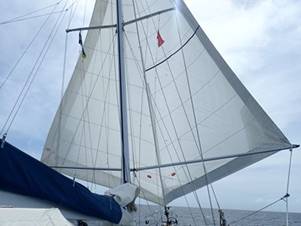


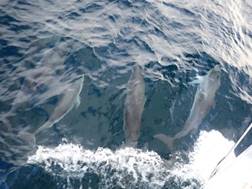 Dolphins are always a joy to be accompanied by!
Dolphins are always a joy to be accompanied by!







